A stain remover targets and breaks down specific substances causing visible marks on fabrics or surfaces, effectively restoring cleanliness. An odor neutralizer works by eliminating or masking unpleasant smells, ensuring a fresh and inviting environment without necessarily removing stains. Choosing the right product depends on whether the priority is eradication of physical blemishes or improvement of air quality.
Table of Comparison
| Feature | Stain Remover | Odor Neutralizer |
|---|---|---|
| Purpose | Eliminates visible stains from fabrics and surfaces | Removes and neutralizes unpleasant odors |
| Active Ingredients | Enzymes, surfactants, solvents | Odor absorbers, antibacterials, masking agents |
| Use Case | Clothing, upholstery, carpets | Rooms, fabrics, trash areas |
| Effect Duration | Immediate stain removal | Long-lasting odor control |
| Application | Spot treatment before washing | Spray or diffuse in affected areas |
| Result | Clear, stain-free surfaces | Fresh, odor-free environment |
Understanding the Difference: Stain Remover vs Odor Neutralizer
Stain removers target and break down specific substances like food, ink, or grease to eliminate visible marks on fabrics or surfaces, utilizing enzymes or chemical agents designed for deep cleaning. Odor neutralizers focus on eliminating unpleasant smells by chemically neutralizing odor-causing molecules or masking them with fragrances, improving air and surface freshness without necessarily removing visible stains. Choosing the right product depends on the issue--visible discoloration requires a stain remover, while persistent smells call for an odor neutralizer, as their mechanisms and purposes differ significantly.
How Stain Removers Work on Tough Messes
Stain removers break down tough messes by targeting and dissolving specific molecules in stains such as oils, proteins, and dyes, often using enzymes and surfactants for effective removal. Their chemical composition allows them to penetrate fabric fibers, lifting and breaking apart the stain particles for easy rinsing. Unlike odor neutralizers that focus on eliminating smells, stain removers prioritize molecular disruption to restore surfaces and fabrics to a clean, stain-free state.
The Science Behind Odor Neutralizers
Odor neutralizers work by chemically binding to odor-causing molecules, transforming them into neutral, non-volatile compounds that cannot be detected by the human nose. Unlike stain removers that primarily break down colored compounds to eliminate visible marks, odor neutralizers target volatile organic compounds (VOCs) responsible for unpleasant smells. Advanced formulations often incorporate enzymes or activated charcoal to accelerate the breakdown and absorption of odor molecules at a molecular level.
Common Types of Stains and Their Best Treatments
Enzyme-based stain removers excel at breaking down organic stains like food, blood, and grass, while oxygen bleach products effectively tackle tough, non-organic stains such as coffee, wine, and ink. Odor neutralizers often contain activated charcoal or baking soda, which absorb and eliminate smells from sources like pet accidents, smoke, and mildew. Selecting the right product depends on identifying the stain type to apply enzymatic action for organic residues or odor-neutralizing agents for persistent smells.
Neutralizing Unpleasant Odors: Methods and Benefits
Stain removers primarily target discolorations by breaking down and lifting stains from fabric or surfaces, whereas odor neutralizers focus on eliminating unpleasant smells at the molecular level using agents like activated charcoal or baking soda. Neutralizing unpleasant odors improves indoor air quality and creates a fresher living environment by removing the source rather than masking it with fragrances. Effective odor neutralizers contribute to healthier spaces by reducing airborne bacteria and allergens associated with persistent smells.
Stain Remover Ingredients: What Makes Them Effective?
Stain removers contain powerful enzymes such as protease, amylase, and lipase that break down protein, starch, and fat-based stains at the molecular level, enhancing their effectiveness. Key ingredients like hydrogen peroxide and oxygen-based bleaches target discoloration by oxidizing stain molecules without damaging fabrics. These active ingredients differentiate stain removers from odor neutralizers, which primarily utilize odor-absorbing compounds like activated carbon or antimicrobial agents rather than enzymatic or bleaching components.
When to Choose a Stain Remover Over an Odor Neutralizer
Choose a stain remover over an odor neutralizer when dealing with visible stains such as coffee, wine, or grass marks that require targeted chemical action to break down pigment molecules. Stain removers contain enzymes or bleaching agents designed specifically to lift and remove discoloration from fabric or surfaces, whereas odor neutralizers primarily mask or eliminate smells without affecting stains. Using a stain remover is essential for restoring the appearance of textiles or carpets affected by spots, ensuring thorough cleaning beyond just odor control.
Dual-Action Products: Do They Really Work?
Dual-action cleaning products combine stain remover and odor neutralizer formulas to tackle both visible stains and lingering smells in one application. These products often contain enzymes and surfactants that break down organic matter causing stains while neutralizing volatile compounds responsible for odors. Consumer reviews and lab tests indicate that while effectiveness varies by brand and stain type, dual-action cleaners generally provide convenience and satisfactory results on common household messes.
Safety Considerations for Stain and Odor Removal
Stain removers often contain strong chemicals like enzymes and solvents that effectively break down tough stains but require careful handling to avoid skin irritation and respiratory issues. Odor neutralizers typically use safer, less abrasive ingredients such as activated carbon or essential oils, minimizing the risk of allergic reactions and toxicity. Choosing products with clear safety labels and following usage instructions helps ensure effective stain and odor removal without compromising indoor air quality or user health.
User Tips: Maximizing Results With Stain Removers and Odor Neutralizers
To maximize results with stain removers, treat stains promptly by applying the product directly to the affected area and allowing it to penetrate before washing with the appropriate water temperature. For odor neutralizers, ensure thorough application on fabrics or surfaces, allowing sufficient drying time to eliminate trapped odors effectively. Combining both products strategically enhances fabric cleanliness and freshness without causing damage.
Stain remover vs Odor neutralizer Infographic

 productdif.com
productdif.com